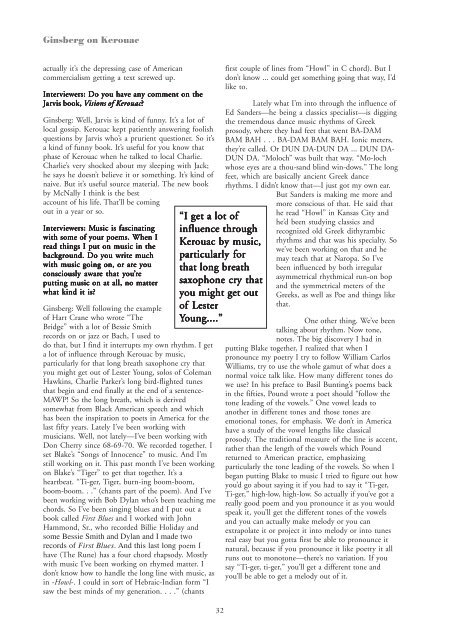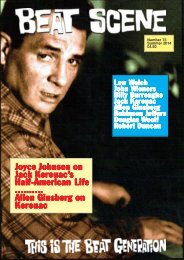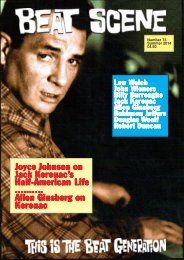Create successful ePaper yourself
Turn your PDF publications into a flip-book with our unique Google optimized e-Paper software.
Ginsberg on Kerouac<br />
actually it’s the depressing case of American<br />
commercialism getting a text screwed up.<br />
Interviewers: Do you have any comment on the<br />
Jar<br />
arvis book, Visions of Ker<br />
erouac<br />
ouac?<br />
Ginsberg: Well, Jarvis is kind of funny. It’s a lot of<br />
local gossip. Kerouac kept patiently answering foolish<br />
questions by Jarvis who’s a prurient questioner. So it’s<br />
a kind of funny book. It’s useful for you know that<br />
phase of Kerouac when he talked to local Charlie.<br />
Charlie’s very shocked about my sleeping with Jack;<br />
he says he doesn’t believe it or something. It’s kind of<br />
naive. But it’s useful source material. The new book<br />
by McNally I think is the best<br />
account of his life. That’ll be coming<br />
out in a year or so.<br />
Inter<br />
ntervie<br />
viewers: ers: Music is fascinating<br />
with some of your poems. When I<br />
read things I put on music in the<br />
background. Do you write much<br />
with music going on, or are you<br />
consciously aware e that you<br />
ou’re<br />
putting music on at all, no matter<br />
what kind it is?<br />
Ginsberg: Well following the example<br />
of Hart Crane who wrote “The<br />
Bridge” with a lot of Bessie Smith<br />
records on or jazz or Bach, I used to<br />
do that, but I find it interrupts my own rhythm. I get<br />
a lot of influence through Kerouac by music,<br />
particularly for that long breath saxophone cry that<br />
you might get out of Lester Young, solos of Coleman<br />
Hawkins, Charlie Parker’s long bird-flighted tunes<br />
that begin and end finally at the end of a sentence-<br />
MAWP! So the long breath, which is derived<br />
somewhat from Black American speech and which<br />
has been the inspiration to poets in America for the<br />
last fifty years. Lately I’ve been working with<br />
musicians. Well, not lately—I’ve been working with<br />
Don Cherry since 68-69-70. We recorded together. I<br />
set Blake’s “Songs of Innocence” to music. And I’m<br />
still working on it. This past month I’ve been working<br />
on Blake’s “Tiger” to get that together. It’s a<br />
heartbeat. “Ti-ger, Tiger, burn-ing boom-boom,<br />
boom-boom. . .” (chants part of the poem). And I’ve<br />
been working with Bob Dylan who’s been teaching me<br />
chords. So I’ve been singing blues and I put out a<br />
book called First Blues and I worked with John<br />
Hammond, Sr., who recorded Billie Holiday and<br />
some Bessie Smith and Dylan and I made two<br />
records of First Blues. And this last long poem I<br />
have (The Rune) has a four chord rhapsody. Mostly<br />
with music I’ve been working on rhymed matter. I<br />
don’t know how to handle the long line with music, as<br />
in -Howl-. I could in sort of Hebraic-Indian form “I<br />
saw the best minds of my generation. . . .” (chants<br />
“I get a lot of<br />
influence through<br />
Kerouac by music,<br />
particularly for<br />
that long breath<br />
saxophone cry that<br />
you might get out<br />
of Lester<br />
Young....”<br />
32<br />
first couple of lines from “Howl” in C chord). But I<br />
don’t know ... could get something going that way, I’d<br />
like to.<br />
Lately what I’m into through the influence of<br />
Ed Sanders—he being a classics specialist—is digging<br />
the tremendous dance music rhythms of Greek<br />
prosody, where they had feet that went BA-DAM<br />
BAM BAH . . . BA-DAM BAM BAH. Ionic meters,<br />
they’re called. Or DUN DA-DUN DA ... DUN DA-<br />
DUN DA. “Moloch” was built that way. “Mo-loch<br />
whose eyes are a thou-sand blind win-dows.” The long<br />
feet, which are basically ancient Greek dance<br />
rhythms. I didn’t know that—I just got my own ear.<br />
But Sanders is making me more and<br />
more conscious of that. He said that<br />
he read “Howl” in Kansas City and<br />
he’d been studying classics and<br />
recognized old Greek dithyrambic<br />
rhythms and that was his specialty. So<br />
we’ve been working on that and he<br />
may teach that at Naropa. So I’ve<br />
been influenced by both irregular<br />
asymmetrical rhythmical run-on bop<br />
and the symmetrical meters of the<br />
Greeks, as well as Poe and things like<br />
that.<br />
One other thing. We’ve been<br />
talking about rhythm. Now tone,<br />
notes. The big discovery I had in<br />
putting Blake together, I realized that when I<br />
pronounce my poetry I try to follow William Carlos<br />
Williams, try to use the whole gamut of what does a<br />
normal voice talk like. How many different tones do<br />
we use? In his preface to Basil Bunting’s poems back<br />
in the fifties, Pound wrote a poet should “follow the<br />
tone leading of the vowels.” One vowel leads to<br />
another in different tones and those tones are<br />
emotional tones, for emphasis. We don’t in America<br />
have a study of the vowel lengths like classical<br />
prosody. The traditional measure of the line is accent,<br />
rather than the length of the vowels which Pound<br />
returned to American practice, emphasizing<br />
particularly the tone leading of the vowels. So when I<br />
began putting Blake to music I tried to figure out how<br />
you’d go about saying it if you had to say it “Ti-ger,<br />
Ti-ger,” high-low, high-low. So actually if you’ve got a<br />
really good poem and you pronounce it as you would<br />
speak it, you’ll get the different tones of the vowels<br />
and you can actually make melody or you can<br />
extrapolate it or project it into melody or into tunes<br />
real easy but you gotta first be able to pronounce it<br />
natural, because if you pronounce it like poetry it all<br />
runs out to monotone—there’s no variation. If you<br />
say “Ti-ger, ti-ger,” you’ll get a different tone and<br />
you’ll be able to get a melody out of it.





